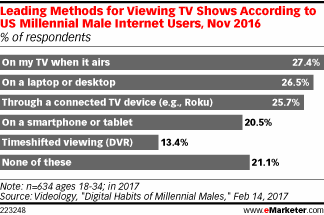A survey suggests only a third will pay for TV this year.
Are millennial males abandoning pay TV in droves? Or are they only slightly less likely than older generations to be pay TV subscribers?

A February 2017 report by Videology found that just one-third of millennial males expect to pay for cable in 2017, with more than half saying they had already cut the cord.
Millennial TV habits have been a source of worry for the TV industry for several years, as have other generational quirks, such as an apparent resistance to owning cars. The Videology survey, if reflective of broad, generational habits, would suggest that the time to worry has passed, and the time to panic has arrived.
Before reaching for the nitroglycerin pills, consider: The Videology survey group was relatively small—it reflected the responses of a fairly small group of young males (at least 500 answered each question), surveyed online. And it stands in stark contrast to other data about cord-cutting.
For example, eMarketer in December 2016 estimated that 6% of US households will cut the cord in 2017. GfK put the number higher, at 12% of US households. Even if cord-cutting was limited solely to millennial households, with every non-millennial household continuing to pay for TV, the numbers would be out of alignment.
Data about generational cord-cutting is relatively scant, but SNL Kagan (now S&P Global) data from 2015 actually found that older users made up the largest portion of US cord-cutters. That data suggested that cord-cutting reflected economics more than age—it found that nearly 60% of cord-cutters were part of households where income fell short of $50,000.
But Pew Research Center data from 2015 contained hints for the potential of a dramatic shift suggested by the Videology survey. In July 2015, Pew said, only 65% of young adults (ages 18 to 29) in the US had pay TV at home.
When thinking about young males specifically, that Pew data seems to foreshadow, not refute, the Videology data.
Dramatic as the Videology data is, and distant though it may be from other numbers, it clearly reflects some fundamental economic and cultural truths about millennial males.
More US millennial males live at home, with their parents, than with a spouse or a partner, according to a Pew analysis of 2014 census data. For those young males, pay TV is likely not their decision to make, but up to the parents of the household.
Meanwhile, the Pew study noted, “young men’s wages (after adjusting for inflation) have been on a downward trajectory since 1970 and fell significantly from 2000 to 2010.”
More recent data has shown some—but not a dramatic amount—of easing of wage pressure, and employment levels have improved, but longitudinal studies of the impact of economic disruptions shows that workers who begin their careers during times of recession will tend to feel the effects for years and years.
In fact, the National Bureau of Economic Research reported that the earnings effect of graduating into a recession does not actually disappear until 10 years after graduation. If that pattern has held out in the wake of the dramatic, global downturn of 2008, millennials are still feeling at least some aftershocks of the Great Recession.
Meanwhile, as found in the Videology study, millennials tend to see digital devices as more critical to their lives than TV, so it would makes sense that lingering financial pressures would lead them to devalue pay TV access.
“Digital video services are luring millennials with everything from NFL games to top-quality dramas to live streams of breaking news events,” said Paul Verna, digital video analyst at eMarketer. “Much of this content is geared toward mobile and connected TV screens, which millennials tend to prefer over traditional TV. These trends argue for an acceleration of a pattern we’ve been tracking for some time: the reluctance of millennials to pay for cable bundles when digital alternatives suit them just fine, and in many cases better.”
So while it may be tempting to view Videology’s numbers as overly dramatic, the data points to generational shifts that could spell major challenges for pay TV.
– See more at: https://www.emarketer.com/Article/Young-Males-Cutting-Cord-Good/1015241?ecid=NL1001#sthash.5ViWvk30.dpuf
by: Ezra Palmer
Source: eMarketer, February 2017

